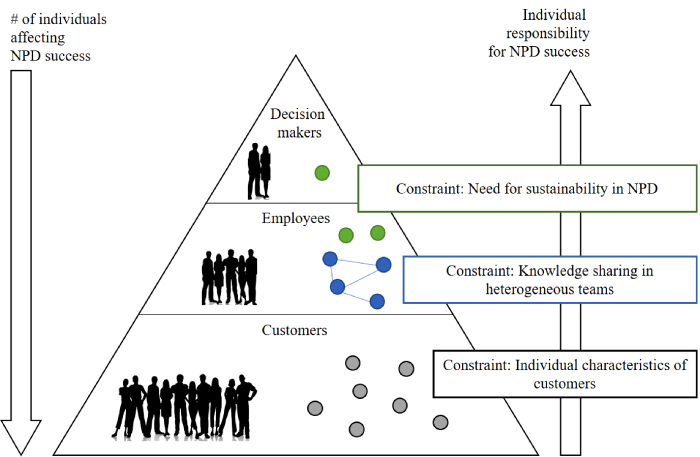Part 1
INDIVIDUAL CONSTRAINTS IN NEW PRODUCT DEVELOPMENT
Individually arising innovation constraints are imposed by or come to life through individuals who effect new product development (NPD) success. Those individuals can be customers of the new product or service, employees in the company who spend their time developing new products and services, or managers within the firm who make decisions about projects or manage innovation teams. While other types of individuals also may potentially influence new product success (e.g. suppliers and other external stakeholders), internal innovation employees and customers are the most common and account for the largest part of success or failure of new products. This first part of the book focuses on overcoming individual constraints exhibited by innovation managers (Chapter 1), members of product development teams (Chapter 2), and customers (Chapter 3), as illustrated in Figure P1.1.

Figure P1.1: Individual constraints in NPD.
In the standard innovation process (see the introduction), several gates determine when and how decision makers evaluate an innovation project and decide if it will proceed to the next stage or if it will be terminated. While ideally those decisions are based on rational predetermined decision criteria, in reality decision makers frequently use intuition or rely on personal biases to make decisions, especially in situations with high uncertainty and complexity, as is the case for NPD decisions. In the end, it is the interplay among risk, uncertainty, and decision maker characteristics that influences the decision-making process and leads individuals to select one project over another.
Chapter 1 in this part analyzes the role of uncertainty and creativity in decisions for NPD projects. The chapter considers constraints due to individuals in the firm and their managers who must combine knowledge and resources in new ways to create an innovation. In general, both research and practice agree that successful NPD needs highly creative and committed individuals as well as facilitation. Research highlights that individual innovative behavior in the workplace is determined by individual characteristics, exchange with and support from supervisors, and organizational commitment. It is the task of the organization to make sure that the creative potential of its employees is realized and that no constraints hinder the birth and growth of innovative projects.
Communication and knowledge-sharing boundaries are critical constraints that can prevent NPD teams from working creatively and efficiently. Chapter 2 tackles these constraints, specifically focusing on NPD teams that consist of individuals with different backgrounds and expertise. Based on a systematization of knowledge-sharing boundaries, the authors present a five-stage solution on how to make knowledge sharing work, despite the interdisciplinarity and heterogeneity of individuals on NPD teams.
Arguably the most crucial group that directly affects NPD success is customers, because they ultimately choose to adopt or reject an innovation. Customer constraints at the individual level differ from constraints in the market in aggregate, which are dealt with in Part 3 of this book. Chapter 3 builds on research that has found that, for individual customers, usage intensity of the product category, income, individual innovativeness, and susceptibility to normative influence determines whether an individual tries a new product or not. It is not people's demographics or position in society that drives their intention to adopt a new product or service as much as their psychographics, or values and attitudes, such as product involvement, individual innovativeness, and opinion leadership. Not all potential customers are created equal; it is their individual differences that can constrain the success of new products and services. Chapter 3 thus takes a deep dive into the personality of customers and depicts identity-related, cognitive, and emotional constraints that prevent individuals from adopting new products and services. After explaining the roots of these constraints, the author shows how to identify them and provides ideas about strategies that help to overcome those trait-based constraints.
